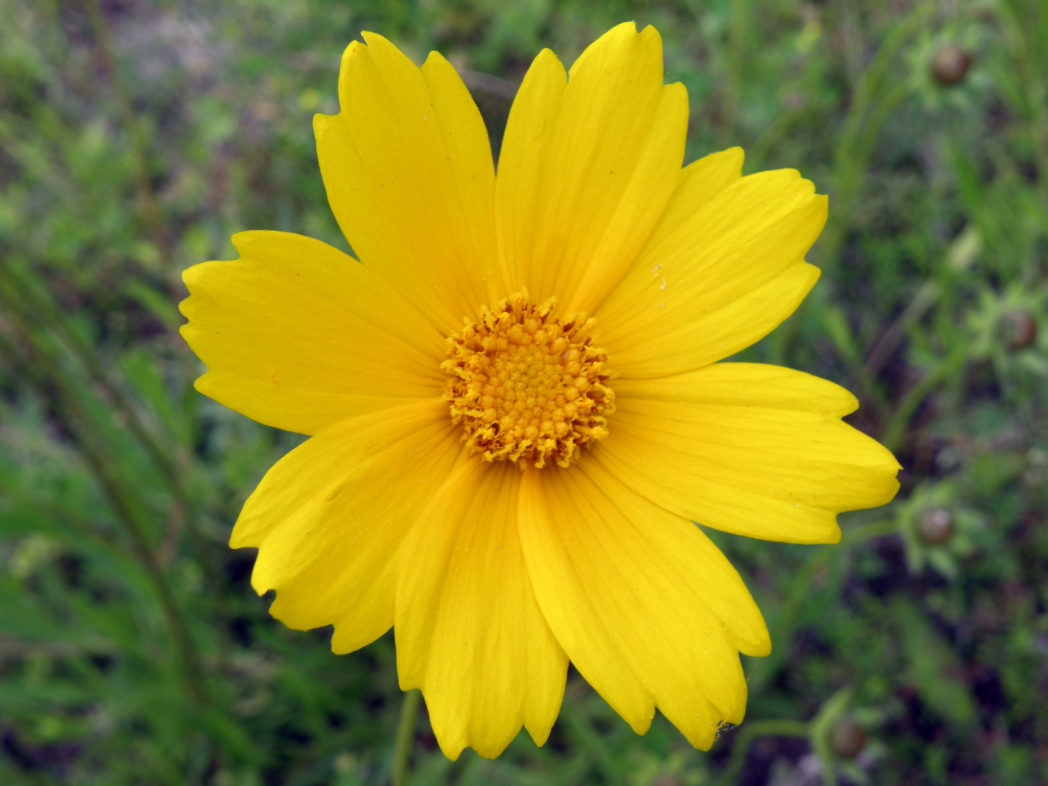Tickseeds – Are you playing matchmaker?
Pictured above: Lanceleaf tickseed (Coreopsis lanceolata) by Stacey Matrazzo
by Jeff Norcini and Zhanao Deng
A concern was recently raised about planting two species of tickseed (Coreopsis spp.) near each other in a garden because the two might hybridize. If they were both Florida ecotypes, so what if they did? It’s probably a hybridization that Mother Nature has already attempted, since she has been in that business since the dawn of sexual reproduction.
A prime example of one of her Tickseed matchmaking successes is Florida tickseed (C. floridana). According to one expert, this species is probably a hybrid of two Florida natives – Texas tickseed (C. linifolia) and coastalplain tickseed (C. gladiata). This hybrid is the only tickseed that is endemic to Florida – that is, it occurs no other place in the world.
But back to the question – what’s the likelihood that two tickseed species will produce a sustainable hybrid? Here’s the general part of that answer: Tickseed species must be flowering at the same time and be close enough together so that the pollinator (bee, butterfly, etc.) transfers pollen from one plant to the other. After that, it gets a bit more technical, but the bottom line is that viable seeds must be produced, and those seeds must germinate and develop into healthy, first-generation hybrid plants.
Moreover, the first generation hybrid plants must be able to produce healthy, seed-producing second-generation plants, the second generation produce a third generation, and so on. Therein lays the downfall of many potential hybrids. Some seeds and first-generation plants may be produced, but seeds for the second generation often are not produced, or the second-generation seedlings may be unhealthy and the potential hybrid species fades into oblivion.
The specific part of that answer deals with our Florida tickseed species, and for that the focus will be on those tickseed species in Florida that are most commonly available as plants or seeds: goldenmane tickseed (C. basalis), lanceleaf tickseed (C. lanceolata), Leavenworth’s tickseed (C. leavenworthii), and plains tickseed (C. tinctoria). One other tickseed will be included as well – largeflower tickseed (C. grandiflora). While its availability is extremely limited at best, largeflower tickseed is the parent species to a number of popular garden varieties that are widely available such as Baby Sun, Early Sunrise, Presto and Sunray.
Hybridization is only likely to occur between tickseed species that are closely related. Those tickseeds are grouped into what botanists refer to as sections. Hybridization between two species from different sections is very rare. Goldenmane tickseed, lanceleaf tickseed, and largeflower tickseed are in a section that includes several other tickseeds. Leavenworth’s tickseed and plains tickseed are in another section, which also includes a species that occurs in Mexico. Hence, planting Leavenworth’s tickseed near any other tickseed, except plains tickseed, poses no practical risk of hybridization. However planting Leavenworth’s and plains tickseed within 100 ft of each other is likely to result in hybridization of the two species.
Within the lanceleaf tickseed section, the only concern is with lanceleaf and largeflower tickseeds. Do not plant garden varieties of these species in the of each other as there is substantial risk the two might hybridize.
One final note – don’t plant tickseed from some other part of the country near the same species of tickseed derived from Florida. The two will likely hybridize, with potentially significant negative ecological impacts.
References:
- Crawford, D.J. and M.E. Mort. 2005. Phylogeny of eastern North American Coreopsis (Asteraceae-Coreopsideae): insights from nuclear and plastid sequences, and comments on character evolution.
- Smith, E.B. 1976. A biosystematic survey of Coreopsis in the Eastern United States and Canada. Sida 6(3):123-215.
- Smith, S.M. 2011. Assessing the potential effects of seed increase and interspecific hybridization on genetic diversity and fitness of Coreopsis leavenworthii. Ph.D. Dissertation. University of Florida, Gainesville. 180 pp.
Jeff Norcini is the owner of OecoHort, LLC.
Zhanao Deng is Professor of Ornamental Plant Breeding and Genetics at the University of Florida/IFAS, Gulf Coast Research & Education Center.

